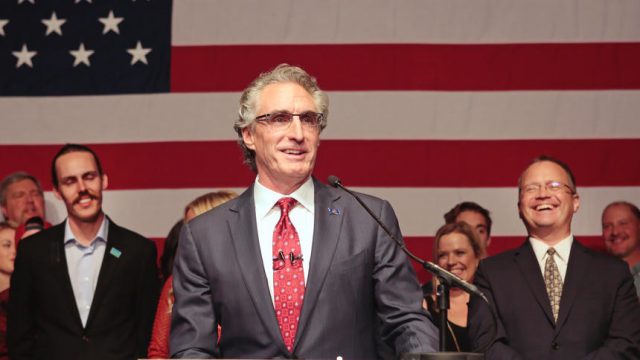Trying to Solve a Spending Problem With Tax Hikes Is a Fool’s Errand

Doug Burgum addresses the crowd after winning the office of governor Tuesday night, Nov. 8, 2016, at the Sanctuary Events Center in Fargo. Brent Sanford, at right in the photo, is the new Lt. Governor Dave Wallis / The Forum
Here’s a simple truth about governance: Spending increases are easy. Spending cuts are really, really hard.
North Dakota is currently learning that lesson. Per data put together by Legislative Council, our state’s general fund spending increased more than 167 percent from the 2007-2009 biennium to the peak of the oil boom in the 2013-2015 biennium.
Even counting the spending reductions in the current biennium, the average biennial increase in spending over the last decade was over 25 percent.
On top of that, spending out of our state’s special funds increased 149 percent:
This was easy to do back when an oil boom, combined with high crop prices, was driving a roaring economy in our state. But now the oil boom has faded, crop prices are in the tank, and the economic activity driving the tidal wave of revenues which made all that spending possible has dried up.
Now lawmakers, heading into the second half of their legislative session, must match spending to this new revenue reality. That’s a tricky prospect, all the more so because government bureaucrats hostile to budget reductions work very hard to make spending cuts as painful as possible.
Meanwhile, Democrats want to cast this problem as a revenue issue, arguing that today’s budget pain wouldn’t be so severe if Republicans hadn’t instituted income tax cuts and oil tax reforms.
They’re hoping this talking point gets traction among voters who have only a loose grasp on the realities of our budget.
One thing worth keeping in mind is that while general fund revenues are down nearly 28 percent (or more than $1.3 billion) they are actually up 38.5 percent (nearly $1 billion) from the pre-oil boom 2009-2011 biennium. Here’s a chart showing the current biennium’s cumulative general fund revenues through January to the previous four biennia:
Put simply, current general fund revenues are still significantly above pre-oil boom revenues.
The problem, then, isn’t revenue. It’s that our state built booming spending growth on top of fleeting oil boom revenues. The solution, then, is a spending correction. Not a futile attempt to recreate, even in part, boom-era revenues with tax hikes.
As to the specific tax policy, it’s worth noting that so far the oil tax reforms passed by lawmakers in 2015 have worked out to be a significant tax hike on the oil industry. While the reform the passed lowered the top oil extraction tax rate, it also eliminated a trigger which lowered the rate to zero when oil prices are low. Because oil prices have been low, the oil industry wouldn’t be paying any extraction tax at all from January, 2016, through today.
Through September of last year – the last month for which data was available when I made a request of Tax Commissioner Ryan Rauschenberger’s office back in November – the oil industry had paid $362 million in taxes they wouldn’t have paid had the Legislature not acted.
As for income taxes, both personal and corporate, the decline in revenues has far more to do with a decline in the number of workers and businesses operating in our state post-oil boom than the modest rate reductions implemented by the Legislature. If anything, raising the income tax rates would only inhibit any potential return of those workers/businesses.
Again, North Dakota’s budget problems have everything to do with spending. Lawmakers budgeted as though oil boom revenues were going to last forever. To the extent the deserve criticism it is for that mistake, not reducing tax burdens.
And the people of North Dakota seem to agree. Governor Doug Burgum railed against spending during his successful campaign last year, and promised not to raise taxes.
He won in a landslide.






